The most common potato diseases and how to combat them
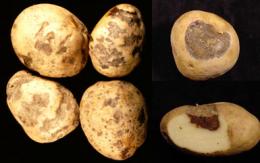
Almost all climatic conditions are suitable for growing potatoes. It does not require special care; it is enough to provide the necessary amount of light and moisture. But we must not forget that there are illnesses potatoes, and fighting them is often difficult. Therefore, you need to know how to provide assistance to this culture.
Content:
Wireworm and late blight
Potatoes can be attacked by a small gray insect called a wireworm. It is a larva of a click beetle. One female lays a huge number of eggs. As a result, wireworm appears, which can destroy the entire crop. For this reason, gardeners should create protection against the beetle itself. To combat pest you can use the following methods:
The potatoes are peeled, strung on a stick, and then immersed in the ground. It is recommended to bury more than one such potato. The larvae will gather on this bait.
After 4 days, you should dig up the potatoes. Pests can be killed with boiling water or fire. When planting a crop, you need to pour sunflower oil into the soil with egg shells, which are finely crushed. This mixture will quickly destroy the wireworm; it will not yet have time to reach the harvest. This solution fights various pests.A few weeks before planting potatoes, you should bury corn grains in the soil. The wireworm will be attracted by the seeds. When the corn sprouts appear, you need to dig up the plants. All larvae are selected and destroyed by boiling water or fire.
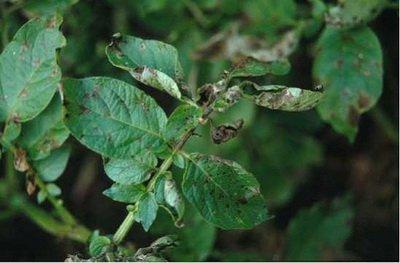
As for late blight, it is also called late blight. Tomatoes and potatoes suffer from this disease. The disease can affect an entire field in just a few weeks. As a result, the gardener loses most of his harvest. Late blight occurs due to fungal spores, so it can infect a large number of tubers in a short time, as it moves under the ground. Initially, the disease is accompanied by darkening of the foliage. A white coating appears on the inside of the leaves. This indicates that the fungal spores are beginning to germinate. After some time, they fall to the ground and begin to infect the root system. Next, brown spots will appear on the tubers.
This dangerous mushroom must be destroyed. To do this, you should adhere to the following rules:
- It is recommended to grow potato varieties that are resistant to late blight.
- For planting, you need to use only good planting material.
- It is recommended to treat tubers with fungicidal preparations.
- Culture needs systematic hilling.
- Apply phosphorus-potassium fertilizers.
- Spray with a mixture of copper sulfate.
- Before harvesting, the tops should be removed.
Rhizoctonia and blackleg
Potatoes are especially susceptible to this disease in wet weather. Brown sores develop on the emerging sprouts. This causes them to turn black and die. The disease is caused by a fungus that survives the winter in the soil. It resembles tubercles similar to soil.Not only sprouts suffer from rhizoctonia, but also adult plants. Brown sores appear on their necks. This causes the plant to wilt, the foliage to curl, and the stem to die. This wilting can be noticed in dry weather. Eventually the roots will begin to die. This disease should also be combated. Often rhizactoniosis appears only in weak plants. For this reason, it is recommended to do everything to ensure that the seedlings develop well and gain strength.
This is a bacterial disease. It begins its development after some time, when shoots appear. The foliage takes on a yellow tint, curls up, and dries. Then the rhizome rots and the stem often turns black. In such a situation, the plant is easily pulled out of the ground. Infection occurs tubers, their pulp turns into mucus and smells unpleasant.
If the soil is poorly moistened and the weather is warm, the development of the disease may be stopped. This makes all signs of the disease disappear. But the plants remain infected, which will become apparent over time. The infection remains in beds that have not been properly harvested. Blackleg disease must be combated. To do this, before storing the crop in the fall for planting, it should be sprayed with a fungicide solution and then dried well.
The plant that is sick must be eliminated from the soil, and the hole is treated with a mixture of ash and copper sulfate. In addition, you can use the treatment of plants with chalk and crushed charcoal. To combat the disease, you need to adhere to the sowing rules. You should choose healthy tubers for landing. As soon as signs of the disease are noticed, the infected bush must be removed. But this must be done carefully so that the disease does not spread to neighboring plants.
Common scab
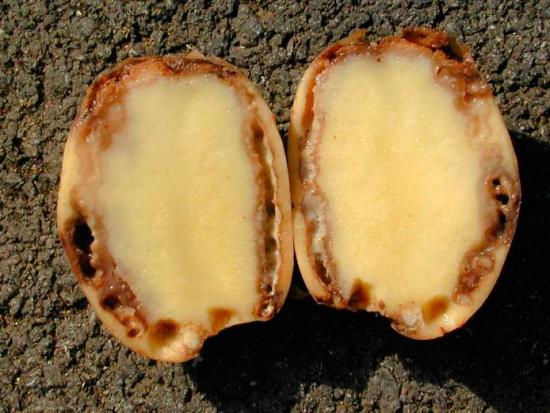
Many people who grow potatoes have encountered this disease. Its development occurs on the surface of the tubers. The disease manifests itself in the form of ulcers, which differ in shape and size. As a result, potatoes lose their presentation and become less tasty. To combat scab, prevention should be carried out. To do this you need to adhere to the following rules:
- Potatoes are planted in crop rotation
- Only healthy tubers are used for planting
- Varieties that are resistant to scab are used
Gardeners need to pay attention to the manure that is applied to the potatoes. It shouldn't be rotten. Don't add too much lime either.
Macrosporiosis and ring rot
This disease manifests itself at the end of June, and its development occurs throughout the summer. It provokes the appearance of dark brown spots that have a round shape. In the place where the lesion occurred, the leaf dies, resulting in holes in the foliage. To protect potatoes from this illnesses, the owners carefully collect plant remains after harvesting. As soon as the first signs of macrosporiosis appear, it is recommended to spray the potatoes with Bordeaux mixture. If planting occurs on peat soils, then potassium fertilizers should be added to it.
Ring rot is a common disease. It provokes the death of the plant, and the tubers begin to rot when they are left for storage. This disease can be noticed during the flowering period.Initially, several stems die, and then all the others wither. They sink to the ground, and inside they can often be filled with yellow mucus. Gradually, the disease affects the tubers. Dark spots may appear on their surface. Under the skin itself, the flesh becomes too soft.
This disease It is easily transmitted from tuber to plant, so affected potatoes are not used for planting. Soil is not a carrier of the disease. But the disease can manifest itself during the process of cutting potatoes, so cutting tools should be treated. To protect potatoes from disease, only healthy potatoes are planted. The diseased plant should be removed and the knives should be treated well. So, there are many potato diseases. But they can be eliminated if damage to the bush is detected in time.
Video about potato diseases:
Interesting information about the vegetable garden

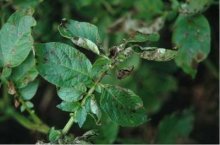
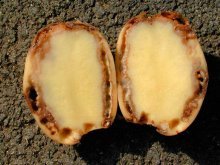
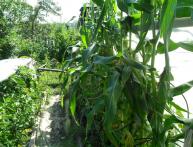
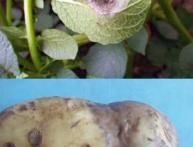
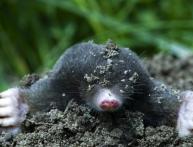

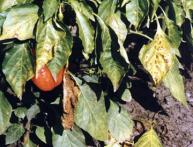

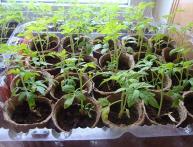

Comments
In my experience, a lot depends on the planting material. I try to buy potatoes for planting only in trusted places, but I use minimal tubers from my own harvest to avoid the spread of diseases next year.